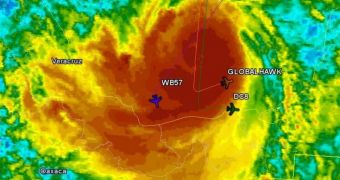Officials at the American space agency announced that last week saw the end of one of their largest ever hurricane studies, entitled the Genesis and Rapid Intensification Processes (GRIP) experiment.
This investigations effort spanned more than two months of non-stop flights, that were carried out in an around the storms that developed during the 2010 Atlantic hurricane season.
The vast amount of data that were collected during this research will most likely keep the international scientific community busy for years to come. This year's work also innovated studies of tropical cyclones.
Though people living in coastal areas around the United States experienced a rather quiet hurricane season, the situation was different in the Atlantic Ocean and the Caribbean Sea.
Weather patterns here allowed researchers with the NASA initiative to collect valid data on the atmosphere. GRIP's main goal is to determine what makes a hurricane tick.
When tropical storms approach populated areas, they can either become massive hurricanes, or subside and release their energy as heavy rain showers. The factors causing either of the two scenarios are still a mystery.
NASA was also interested in determining what was it about hurricanes that allowed for their trademark rapid intensification. This type of events often caught people off-guard when storms developed.
The space agency used two manned aircraft, a DC-8 and a WB-57, and a remotely piloted UAV, the Global Hak, to carry out its investigations.
GRIP “was successful beyond my reasonable expectations. It requires cooperation with the weather and good luck with the aircraft,” Ed Zipser explains.
“It's not so much a logistical challenge as it is a toss of the dice by Mother Nature during our time available. But it takes a good airplane, a skillful crew and good luck with the equipment,” he adds.
Zipser was a GRIP mission scientist, who is based at the University of Utah in Salt Lake City. Experts from the NASA Jet Propulsion Laboratory (JPL), in Pasadena, California, were also involved in the study.
“We're all very pleased we were able to get the Global Hawk over a hurricane. There was a question about that,” adds Gerry Heymsfield, a mission scientist from the Goddard Space Flight Center.
“That's a major accomplishment both on the science side and the capability side. It really paves the way for future research,” he concludes.

 14 DAY TRIAL //
14 DAY TRIAL //